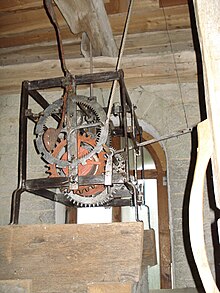St. Andreas (Ostönnen)
The Protestant village church of St. Andreas is a listed church building in Ostönnen . Its Gothic organ , along with the instruments in Sion , Kiedrich and Rysum, is one of the oldest playable organs in the world.
history
The Ostönner church was first mentioned in a document in 1169. During excavations it was found that two predecessor churches existed. The current nave rests on even older foundations . During renovation work, a thick layer of fire was found in the floor, an indication of a wooden church .
While the west tower from the first half of the 12th century comes from an older predecessor, the older nave was replaced by a basilica made of Soest green sandstone in the second half of the 12th century . The nave with two bays and the choir apse are clearly separated from each other in Romanesque construction. The central nave is raised. All components are covered with arches. The square of the choir and tower are almost as big as the squares of the central nave. In 1979 the entire building was plastered and repainted in the presumed original color.
Murals
Between 1959 and 1961, Romanesque wall paintings were uncovered during restoration work. At the beginning of the 13th century, the three-dimensional room structure was supplemented by numerous wall paintings. On the wall of the central nave there is a graceful column triforium . In the vaults you can see ridge bands with stylized trees of life and mythical animals.
The apse was painted in the jagged style in the third quarter of the 13th century , the figural mural is only preserved in the upper part. It shows Christ in the center in the mandorla, represented as the judge of the world . He is supported by a bishop, a woman, a young man with a patriarchal cross and another woman with a palm branch. The four signs of the evangelists - bull, eagle, man and lion - frame the apse painting.
organ
The organ , the oldest parts of which were made in the first half of the 15th century, stood in the Alt St. Thomae church in Soest before it was moved to Ostönnen in 1721/22. Today it stands at ground level in front of the west wall of the tower room, which is almost completely open to the nave, and was extensively restored between 2000 and 2003. Well over 50 percent of the pipes and the drawer as well as parts of the case date from the time they were made. This makes it probably the oldest playable organ in the world.
tower
The tower was built independently from the rest of the church in the first half of the 12th century. It has a square floor plan and rises in five floors of 4.50 m each. He is not in a fixed wall connection with the nave. In the tower staircase you can clearly see how the nave was built on. The tower is divided into three arched windows on the upper four floors .
Between 1978 and 1979 the tower was completely renovated. All windows and niches that were walled up in the past have been restored.
Bells
The bell, which was cast on June 24, 1306, is one of the oldest bells in the Soest Börde . It bears the inscription RECTOR COELI NOS EXAUDI. TU DIGNARE NOS SALVARE. ( Lords of Heaven hear us! You are worthy to redeem us. )
Two other bells are replacements for the bells melted down during World War I. These bells, cast in 1919, are of inferior quality, they are porous and have air bubbles.
In addition, a late Gothic clock bell from 1516 hangs on the south side of the tower , it bears the names Maria and Anna . The preserved clockwork dates from 1598.
Furnishing
- Last Supper picture from 1683
- Baptismal font , probably from the previous church and around 1000 years old. It was exhibited for a long time in the Burghofmuseum in Soest.
- Pulpit from 1582 with a relief depicting a bearded man. His official costume with gown and beret and also the beard cut attest to the appearance of a Lutheran pastor at the end of the 16th century.
literature
- Helmut Fleinghaus : Ev.-luth. St. Andrew's Church in Ostönnen . Schnell and Steiner, Regensburg 2004, ISBN 3-7954-6523-0 .
- Georg Dehio: Handbook of the German art monuments. North Rhine-Westphalia II. Westphalia. German art publisher. Munich 2011, pp. 1037-1038.
- Reclam's Art Guide Germany III, Monuments, Rhineland and Westphalia. 1975, ISBN 3-15-008401-6 .
See also
Web links
Individual evidence
- ^ Report on the restoration
- ↑ Ostönnen.de ( Memento of the original from August 15, 2011 in the Internet Archive ) Info: The archive link was inserted automatically and has not yet been checked. Please check the original and archive link according to the instructions and then remove this notice.
- ↑ Reclam's Art Guide Germany III, Monuments, Rhineland and Westphalia, 1975, ISBN 3-15-008401-6 , p. 593
Coordinates: 51 ° 32 ′ 53.8 ″ N , 8 ° 0 ′ 3.5 ″ E



